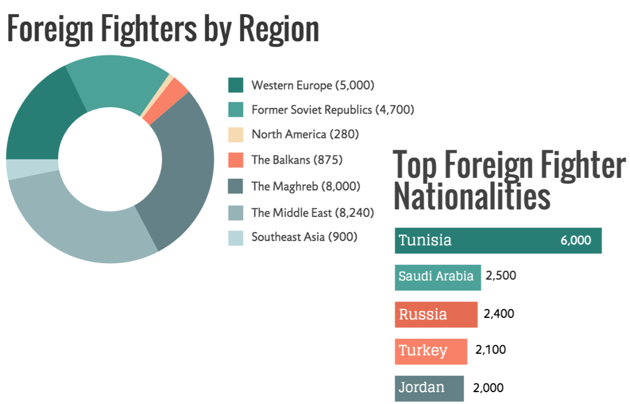Ex-CIA Chief Explains How ISIS/ISIL is Establishing a New Islamic Caliphate
A recent Soufan Group report on foreign fighters in Iraq and Syria (not necessarily fighting with ISIS):

Ending ISIS: An Ex-CIA Chief's Plan
After recent attacks on Paris, Beirut and on a Russian passenger jet, most experts now believe that we are in a global war with the Islamic State. The would-be caliphate differs from past threats — more brutal and uncannily adept at tapping into disaffection. While the global powers do not recognize the Islamic State’s legitimacy, its terror has reached around the world. How can we stop the Islamic State? Defusing the IS, also known as “ISIS” and ”ISIL,” requires understanding first what makes it tick — how it exerts power and why it thrives. But that’s only part of the game plan that is only now developing. In this three-part series, taken from excerpts of his testimony before the House of Representatives’ Armed Services Committee last month, former CIA deputy director John McLaughlin lays out his analysis of the threat and offers a plan of attack. McLaughlin begins here by examining the scourge of the Islamic State, inside out.December 28, 2015
My last four years in government were largely focused on the post-9/11 battle against al-Qaida. Dangerous and challenging as that was, the challenge presented by ISIL exceeds it. This is because for at least the past year, it has been apparent that ISIL has six things al-Qaida never had in anything like the measure ISIL possesses them. No one, therefore, should be surprised that ISIL has shown the capabilities it did in Paris — elaborate planning, stealthy access, deadly tactics.
First, ISIL has a more comprehensive strategy. As the Institute for the Study of War has smartly concluded, we are dealing with an enemy that has a strategy, one the Institute concludes ISIL is executing in three concentric rings. Its “interior” ring includes Iraq, Syria, Jordan, Lebanon and Palestine. Here their objective is to conquer, defend and expand — and, as the Paris attacks show, to plan and execute external operations. Its “near abroad” ring comprises the rest of the Middle East and North Africa, extending out to Pakistan and Afghanistan. Libya is, for now, the main external hub. The objective is to establish affiliates here and increase disorder. In the “far abroad” ring — the United States, Europe, parts of Asia and sub-Saharan Africa — the goal is to attack and polarize.
Second, unlike al-Qaida, ISIL holds territory. By now it has as much as half of Iraq and Syria, with a capital in Raqqa, Syria, and a secondary center in Iraq’s second-largest city, Mosul. Al-Qaida central never succeeded beyond essentially renting part of Afghanistan before 9/11. As long as ISIL has this territory, it has the “caliphate” it claims and therefore the basis for its appeal — a destination for recruits.
Third, it has money. I have heard U.S. Treasury officials publicly put this somewhere between $500 million and $1 billion. Al-Qaida was always scraping for money and seeking loans from more successful terrorists. ISIL’s money comes from taking over about 80 bank branches in Iraq, from taxes, kidnapping, smuggling and oil.
I believe we have never fully grasped the importance of ISIL’s relative wealth. Much of this may be needed to administer its territory, but I’m convinced it still has more money than al-Qaida ever had to buy expertise on things like information technology and weaponry, and to send its recruiters and trainers to places like Libya and operatives to places like France.
Fourth, ISIL has easier access to the West. As Paris vividly illustrates, the 4,500 or so Western recruits among its 20,000 to 30,000 fighters allow ISIL to move among us in ways that are harder to detect than typical al-Qaida operatives.
Fifth, ISIL has a powerful narrative. Its slick propaganda depicts for alienated youth in the West and elsewhere a better life of jobs, homes, fellowship and power. We notice mainly the brutality, but in a single month this summer, 52 percent of the nearly 900 propaganda messages ISIL sent out were focused on quality-of-life issues, while 37 percent hit military themes and only 2 percent touched on brutality. Al-Qaida’s narrative was and remains far less sophisticated and appealing — essentially, go attack the West and then enjoy a dangerous life on the run.
Sixth, ISIL now has rudimentary experience in governing. It’s hard to get accurate data on this, but in many areas ISIL appears to be providing basic services at a tolerable level. They’ve incorporated existing bureaucracies where possible and forced workers at utilities and medical facilities to stay. With the exception of some of Al-Qaida’s affiliates for limited periods, Al-Qaida never got to this point.
John McLaughlin is the former deputy director of the CIA. He writes a regular column on OZY called “The Spy Who Told Me” and teaches at the Johns Hopkins University’s School of Advanced International Studies (SAIS).
Related:
- Exclusive: Seized documents reveal Islamic State's Department of 'War Spoils' Reuters
- Exclusive: Islamic State sanctioned organ harvesting in document taken in U.S. raid Reuters
- Exclusive: Islamic State ruling aims to settle who can have sex with female slaves Reuters



No comments:
Post a Comment